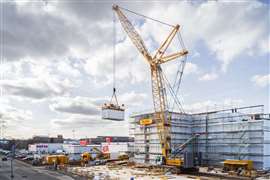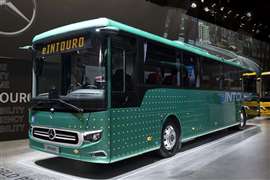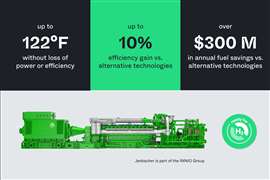Kohler’s focus on cleaner power: a Q&A with Charles Hunsucker
27 April 2023
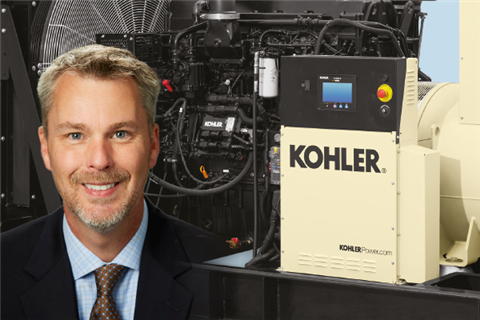 Charles Hunsucker, president of Kohler Power Systems.
Charles Hunsucker, president of Kohler Power Systems.
A lot has been happening at Kohler, from the rebranding of the Kohler Power businesses to Kohler Energy, to the expansion of the company’s flagship KD Series industrial generator line, to the global adoption of hydrotreated vegetable oil (HVO) fuel to the naming of a new president.
Diesel Progress spoke to Charles Hunsucker, appointed Kohler Power Systems president, who outlined the company’s views on a variety of subjects, including energy storage, microgrids and the future of engines.
Kohler recently announced the expansion of the KD Series industrial gen-set line, which now spans a range of 700 kW to 4 MW. What prompted this expansion and do you have plans to add more units to the range?
We launched the KD Series back in 2016. Initially it was 800 to 3250 kW. A couple of years ago, we increased the range, adding 3.5 and 4 MW units. In 2023 we released an 18 L KD Series engine that’s allowed us to bring the KD Series range down to 700 and 750 kW.
It was always part of the plan to continue to expand the series up and down. As far as future growth, I can’t tell you that there’s an imminent plan to take it lower than 700 kW or above 4 MW. What I would say is that we’re always evaluating, we’re looking at a continuous product development strategy, we’re looking at ways to provide energy resilience to the market and we’re trying to do so in a competitive package with better efficiency and a lower carbon footprint.
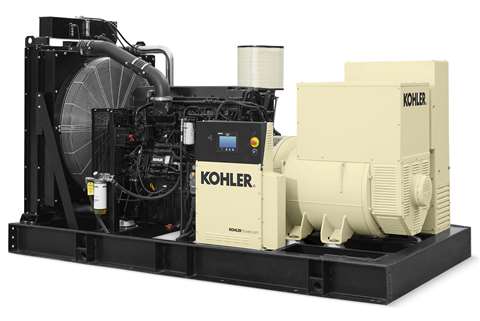 Kohler recently expanded its KD diesel gen-set range with the addition of 700 and 750 kW models. (Photo: Kohler)
Kohler recently expanded its KD diesel gen-set range with the addition of 700 and 750 kW models. (Photo: Kohler)
Within that, we’re going to go where we see the market trending. We have a nice continuum of power, but we’re always continuing to look at the gaps in between. As market leaders, we will continue to develop the space.
In 2021, Kohler launched a line of energy storage batteries for home standby and light commercial applications. Is the company considering expanding into larger energy storage applications for industrial customers such as data centers?
We’ve spent a lot of time, a lot of energy, a lot of market research, and a lot of development analysis to really understand the battery space. And to be candid at this point, we don’t see battery storage as a viable backup system for large industrial applications. The ability to scale, to get enough power for long duration, is just not there yet.
If you’ve been to modern day data centers, you can imagine the amount of space required and the amount of battery packs required to continue to support that. I think there are ways to use batteries in the overall ecosystem of an energy resilience platform, they’re just better suited today for short-term storage, for lower power nodes or for long term at very low loads. It’s a piece of a microgrid, a piece of a smart grid solution.
I don’t see a data center or mission-critical or large-scale industrial applications relying solely on batteries today.
When you’re looking at energy resilience and mission-critical applications, everyone that we speak to, all of our customers, are looking for a way to reduce greenhouse gas emissions and become more sustainable. And if batteries are a way to do that, which is to be determined, the money goes aside.
At the end of the day, the most critical piece is ensuring that you have the backup when you need it, at the moment you need it, for the amount of time you need it. And I don’t think anyone can put that much trust and reliability in batteries today.
Several manufacturers have looked to provide “energy as a service.” Is that something Kohler is considering?
The short answer is no. Energy as a service is not on our strategic platform for our power systems business today. From my standpoint, we have to stay very laser focused on what we do. Our competence and our business model is really to provide energy resilience when someone’s primary energy source fails. We’re going to stay focused on that for now.
Where we could fit into an energy-as-a-service platform is working with third-party providers and we are doing some of that, trying to figure out who the leaders are going to be. We can be a participant in that with them and provide our generators as part of the overall solution.
At this point, we are not looking to own or operate the assets ourselves. We want to be a part of it through a third party and we’re going to stay in our lane and continue to provide backup power.
In 2022, Kohler acquired Heila, a specialist in distributed energy resources and microgrids. What are you doing on microgrids and do you see that as an expanding business?
Heila has been a great addition to the Kohler Energy portfolio. Since bringing them into the overall business, we’ve learned a lot from them. They have some fantastic patented control technology. What they really do is integrate and optimize all types of energy resources, whether that’s batteries and fuel cells, or generators, or solar, or whatever the case may be. And they’re very agnostic, not affiliated with a particular brand or technology.
In these scenarios, they’ll take energy, any energy resource, bring them all together and make them work as an effective microgrid. When we play in that, there’s not a microgrid that I’ve ever seen in which the backbone of that system is not a backup generator. We’re partnering with Heila, they’re partnering with us and we’re continuing to bring each other a lot of opportunities. We’ve already done some things with Heila, microgrid projects through Kohler Power Systems and they’ve also done some projects with Clarke Energy, which is part of the Kohler Energy team.
So we’re learning from them and leveraging their expertise and it’s been fantastic to have them in the business.
The majority of Kohler’s generator products are engine-driven. Is Kohler looking at other low- or zero-carbon alternatives?
We continue to believe that the internal combustion engine has a long road ahead. The amount of reliability that is required for mission-critical applications, it’s going to need that level of proven backup support. That’s why we continue to invest in those technologies.
We do have a responsibility to continue to drive the innovation, and efficiencies, to deliver cleaner technologies. That’s where power density – and moving from fossil fuels to renewable fuels like hydrotreated vegetable oil – is going to continue to be a strong push for us.
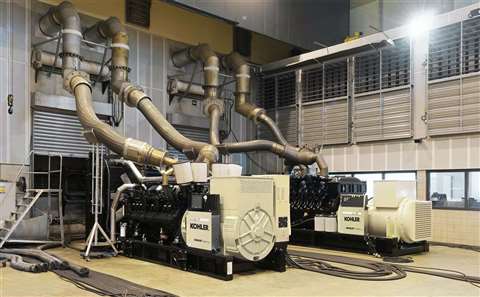 Kohler has adopted HVO as a standard fuel for all of its gen-sets and engines and is also using it for testing at its Brest, France, facilities. (Photo: Kohler)
Kohler has adopted HVO as a standard fuel for all of its gen-sets and engines and is also using it for testing at its Brest, France, facilities. (Photo: Kohler)
When you think about HVO and you think about clean fuel, Europe is light years ahead of where we are in the U.S. Just recently, Amazon Web Services in Europe, just switched an entire data center from fossil fuels over to HVO and our Kohler facility in Brest, France, just did the same thing. We have a very large facility and we switched our fuel usage in that facility to HVO. We’re evaluating it and we’ll gladly do the same thing at all of our other facilities around the world once the HVO supply chain strengthens and it becomes readily available.
We see that as an opportunity to continue to evaluate all of these other resources. I believe there’s going to be a way to keep internal combustion engines, diesel and gas gen-sets, in that infrastructure. We just have to find a way to make them cleaner and more sustainable.
And you know, it’s our job to make sure we’re keeping our eyes on all of it. We have, which you may not be aware of, hydrogen solutions today – engines, fuel cells – that are available. The issue is not the technology, which Kohler has the ability to provide today. The issue is the green hydrogen availability, infrastructure and storage on a long-term basis.
We have the ability, we’ve done a lot of research and development in this space. As hydrogen and other solutions become more readily available, we’ll be in a good position to maximize on it.
You’ve been at Kohler more than 22 years, much of it on the power generation side. How have customer demands changed during that time? What are they asking for now that they didn’t before?
You know, since I’ve been on the energy side, the biggest thing I’ve seen change is the amount of power that customers are requesting. It continues to go up dramatically. We mentioned earlier that we’re at 4 MW. Our customers demanded it and we brought it to market. The amount of units that are being produced on a regular basis is eye opening, it’s phenomenal.
At the same time, back to the carbon discussion, our customers are asking for us to help them hit their sustainability metrics to help them reduce their overall carbon footprint. As you get into these concentrated spaces around the country, or the world, permitting becomes more and more challenging. We as a partner have to play a role in that.
One other change in the last several years for us is that more and more of our customers, particularly the very large customers that have a national or global scale, continue to demand more of a direct personnel relationship from the factory. They want end-to-end service directly from us. They want us to help them design, specify, build the unit, enclose the unit, test it, deliver it, commission it and then ultimately manage the service for them. And they don’t want to necessarily work with a channel partner in California, and then have to work with a different channel partner in Boston or New York or wherever. They want one call to make – some people like to say one throat to choke – and that’s different.
To be clear on this piece, we as a manufacturer are working with and relying more heavily than ever on our channel partners. We can’t do what we do – provide the around the clock service 24/7/365, have the parts there when things happen – without our distributor and channel partners. They’re the ones that go out and fix it immediately. Some of these large customers just don’t want to deal with that, they want us to manage it for them. So that’s a big change and shift in the space and it’s really been driven by the large-scale customers.
If you just step back and look at it, the customer wants more power, they want a smaller footprint or a smaller package, they want less noise, they want less emissions, they want to get it on site faster. It’s a lot of demands that they put on us. And we’re up for the challenge.
POWER SOURCING GUIDE
The trusted reference and buyer’s guide for 83 years
The original “desktop search engine,” guiding nearly 10,000 users in more than 90 countries it is the primary reference for specifications and details on all the components that go into engine systems.
Visit Now
STAY CONNECTED




Receive the information you need when you need it through our world-leading magazines, newsletters and daily briefings.
CONNECT WITH THE TEAM










